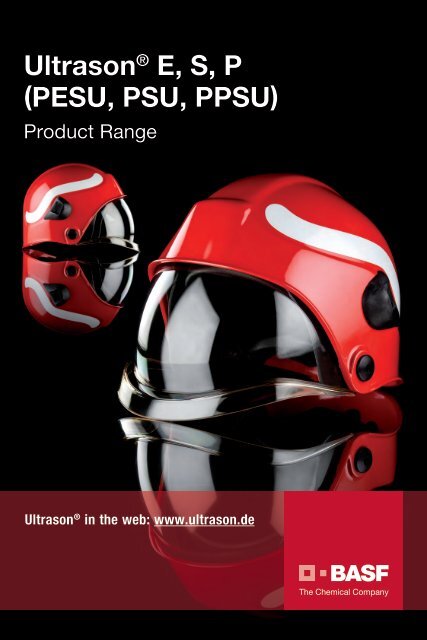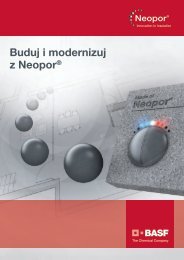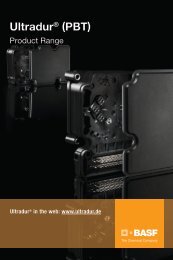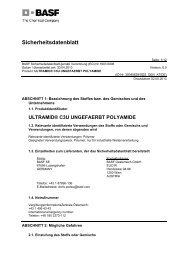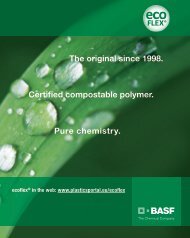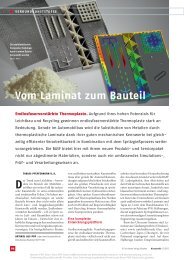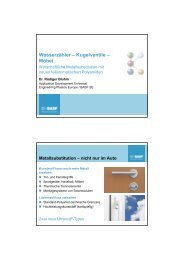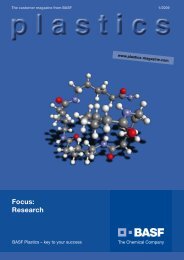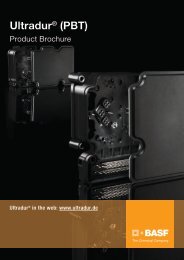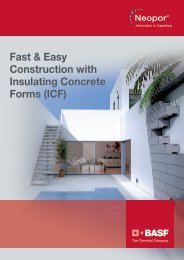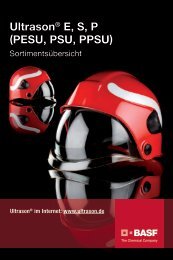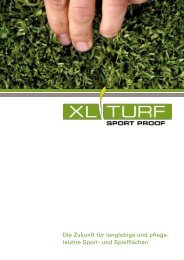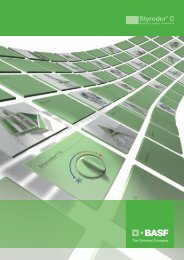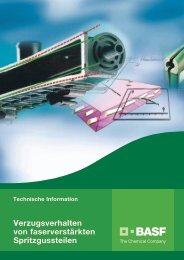Ultrason range chart - Brochure - BASF Plastics Portal
Ultrason range chart - Brochure - BASF Plastics Portal
Ultrason range chart - Brochure - BASF Plastics Portal
You also want an ePaper? Increase the reach of your titles
YUMPU automatically turns print PDFs into web optimized ePapers that Google loves.
<strong>Ultrason</strong> ® E, S, P<br />
(PESU, PSU, PPSU)<br />
Product Range<br />
<strong>Ultrason</strong> ® in the web: www.ultrason.de
<strong>Ultrason</strong> ® E, S, P<br />
The <strong>Ultrason</strong> ® resins are amorphous thermoplastics<br />
derived from polyethersulfone ( PESU),<br />
polysulfone ( PSU) and polyphenylsulfone ( PPSU)<br />
and offer very high resistance to heat. Their wide<br />
spectrum of beneficial properties allows them<br />
to be molded into high-quality engineering parts<br />
and high-load mass-produced articles. They<br />
can be processed by almost all the techniques<br />
adopted for thermo plastics. <strong>Ultrason</strong> ® can be<br />
successfully used for applications in which other<br />
plastics, e. g. polyamide, polycarbonate, polyoxymethylene<br />
and polyalkylene terephthalates,<br />
fail to meet the requirements. By virtue of their<br />
extraordinary versatility, <strong>Ultrason</strong> ® resins can<br />
substitute thermosets, metals and ceramics.
<strong>Ultrason</strong> ® E, S, P<br />
<strong>Ultrason</strong> ® E, S, P<br />
Main features<br />
04<br />
04<br />
<strong>Ultrason</strong> ® GRADES<br />
Reinforced grades<br />
Unreinforced grades<br />
06<br />
06<br />
08<br />
Nomenclature 10
4<br />
<strong>Ultrason</strong> ® E, S, P<br />
Main features<br />
<strong>Ultrason</strong> ® E, S, P<br />
Main features<br />
Temperature independent properties<br />
Very high long-term service temperatures<br />
Good dimensional stability<br />
High modulus<br />
High mechanical strength<br />
Good electrical insulation properties<br />
Good dielectrical properties<br />
Very good fire behaviour<br />
Superior hydrolysis resistance<br />
Headlight bezel<br />
Firefighter’s helmet
<strong>Ultrason</strong> ® E, S, P<br />
Main features<br />
5<br />
Unreinforced grades<br />
<strong>Ultrason</strong> ® E 1010<br />
<strong>Ultrason</strong> ® E 2010<br />
<strong>Ultrason</strong> ® E 2020 P<br />
<strong>Ultrason</strong> ® E 3010<br />
<strong>Ultrason</strong> ® E 6020 P<br />
<strong>Ultrason</strong> ® S 2010<br />
<strong>Ultrason</strong> ® S 3010<br />
<strong>Ultrason</strong> ® S 6010<br />
<strong>Ultrason</strong> ® P 3010<br />
Injection-molding grade of low viscosity and good flowability<br />
Standard injection-molding grade of medium viscosity<br />
Polyethersulfone flakes, for solvent based processes;<br />
product is soluble e. g. in N-Methylpyrrolidone and N,N-Dimethylacetamide<br />
Higher viscosity injection-molding and extrusion grade with improved toughness and<br />
chemical resistance (stress crack resistance)<br />
Polyethersulfone flakes of high molecular weight and good solubility in typical solvents<br />
(N-Methylpyrrolidone, Dimethylacetamide, Dichloro methane) used e. g. in the production of<br />
membranes or coatings<br />
Injection-molding grade of low viscosity and good flowability<br />
Medium viscosity injection-molding and extrusion grade with improved toughness and<br />
chemical resistance (stress crack resistance); with reduced oligomer content<br />
High molecular weight injection-molding and extrusion grade with excellent chemical resistance<br />
(stress crack resistance) and good solubility in typical solvents (N-Methylpyrrolidone, Dimethylacetamide,<br />
Dichloro methane) used e. g. in the production of membranes or coatings, with<br />
reduced oligomer content<br />
Medium viscosity injection-molding and extrusion grade with superior toughness and chemical<br />
resistance (stress crack resistance), resistant against superheated steam<br />
Reinforced grades<br />
<strong>Ultrason</strong> ® E 2010 G4<br />
<strong>Ultrason</strong> ® E 2010 G6<br />
<strong>Ultrason</strong> ® E 2010 C6<br />
<strong>Ultrason</strong> ® S 2010 G4<br />
<strong>Ultrason</strong> ® S 2010 G6<br />
Medium viscosity injection-molding grade of high modulus and strength,<br />
reinforced with 20 % glass fiber<br />
Medium viscosity injection-molding grade of high modulus and strength,<br />
reinforced with 30 % glass fiber<br />
Polyethersulfone, 30 % carbon-fiber-reinforced; grade with extreme high modulus also at<br />
temperatures up to 200 °C<br />
Low viscosity injection-molding grade of high modulus and strength,<br />
reinforced with 20 % glass fiber<br />
Low viscosity injection-molding grade of high modulus and strength,<br />
reinforced with 30 % glass fiber<br />
Table 1: <strong>Ultrason</strong> ® commercial products<br />
Bundle of hollow fibers
6<br />
<strong>Ultrason</strong> ® E, S, P<br />
Reinforced grades<br />
<strong>Ultrason</strong> ® Grades<br />
Reinforced grades<br />
Typical values at 23 °C for uncolored products Unit Test method S 2010 G4<br />
Features<br />
Symbol – ISO 1043 PSU -GF20<br />
Density, apparent density* g /cm 3 ISO 1183 1.38<br />
Viscosity number 1) cm 3 /g ISO 1628 63<br />
Water absorption, equilibrium in water at 23 °C % similar ISO 62 0.7<br />
Moisture absorption, equilibrium 23 °C / 50 % r. H. % similar ISO 62 0.2<br />
Processing<br />
Injection Molding ( M ), Extrusion (E), Blow Molding (B) – – M, E<br />
Glass transition temperature, DSC (10 °C / min) °C ISO 11357-1/-2 187<br />
Melt volume rate MVR 360 °C /10 kg cm 3 /10 min ISO 1133 40<br />
Melt temperature, injection molding °C – 350 - 390<br />
Mold temperature, injection molding °C – 130 -180<br />
Molding shrinkage, in direction of flow % ISO 294 0.31<br />
Molding shrinkage, perpendicular to flow % ISO 294 0.52<br />
Fire behavior<br />
Burning behavior at 1.6 mm thickness class UL 94 V -1<br />
Burning behavior at 3.2 mm thickness class UL 94 V - 0<br />
Mechanical properties<br />
Tensile modulus MPa ISO 527 - 2 6,600<br />
Tensile stress at yield (v = 50 mm /min), stress at break* (v = 5 mm /min) MPa ISO 527 - 2 115 *<br />
Elongation at yield (v = 50 mm /min), elongation at break* (v = 5 mm /min) % ISO 527 - 2 2.9 *<br />
Charpy impact strength 2) +23 °C kJ /m 2 ISO 179 /1eU 50<br />
Charpy impact strength 2) - 30 °C kJ /m 2 ISO 179 /1eU 55<br />
Charpy notched impact strength +23 °C kJ /m 2 ISO 179 /1eA 8<br />
Charpy notched impact strength - 30 °C kJ /m 2 ISO 179 /1eA 8<br />
Izod notched impact strength +23 °C kJ /m 2 ISO 180 /A 8<br />
Izod notched impact strength - 30 °C kJ /m 2 ISO 180 /A 8<br />
Ball intendation hardness H 358 /30 MPa ISO 2039 -1 –<br />
Ball intendation hardness H 961/30 MPa ISO 2039 -1 170<br />
Thermal properties<br />
Heat deflection temperature 1.8 MPa (HDT/A) °C ISO 75 - 2 184<br />
Temperature index (short cycle operations) 3) °C – 180<br />
Relative temperature index related to 50 % decrease of tensile strength after 20,000 h °C UL 746B 160<br />
Coefficient of linear thermal expansion, longitudinal (23-80) °C 10 -4 /K ISO 11359 -1/-2 0.26<br />
Coefficient of linear thermal expansion, longitudinal 140 /180 °C 10 -4 /K ISO 11359 -1/-2 0.28/-<br />
Electrical properties<br />
Relative permittivity (100 Hz /1 MHz) – IEC 60250 3.5 /3.5<br />
Dissipation factor (100 Hz /1 MHz) E - 4 IEC 60250 10/60<br />
Volume resistivity Ω ∙ cm IEC 60093 > 10 13<br />
Surface resistivity Ω IEC 60093 > 10 14<br />
Dielectric strength K20/K20 k V / mm IEC 60243 -1 3 46<br />
Comparative tracking index, CTI, test liquid A – IEC 60112 125<br />
Comparative tracking index, CTI, test liquid B – IEC 60112 125<br />
Optical properties<br />
Refractive index (specimen thickness = 1 mm) – – –<br />
Light transmission (specimen thickness = 2 mm) % ASTM D 1003 –<br />
Footnotes<br />
1 )<br />
Viscosity number, solution 0.01 g /ml<br />
phenol/1,2-dichloro benzene (1:1 )<br />
2 ) N = no break<br />
3) Empirical values determined on articles repeatedly subjected<br />
to the temperature concerned for several hours at a<br />
time over a period of several years on condition that the<br />
articles were properly designed and processed according<br />
to <strong>BASF</strong> recommendations.<br />
4) 4-point method,<br />
acc. ISO 3915<br />
5) <strong>BASF</strong> measurement<br />
6) Flakes with good solubility<br />
for coatings and membranes.<br />
This grade is not<br />
suitable for injection<br />
molding and extrusion.
<strong>Ultrason</strong> ® E, S, P<br />
Reinforced grades<br />
7<br />
S 2010 G6 E 2010 G4 E 2010 G6 E 2010 C6<br />
PSU-GF30 PESU-GF20 PESU-GF30 PESU-CF30<br />
1.46 1.50 1.59 1.47<br />
63 56 56 56<br />
0.6 1.6 1.6 1.7<br />
0.2 0.6 0.6 0.6<br />
M, E M, E M, E M, E<br />
187 225 225 225<br />
30 29 25 15<br />
350 -390 350 -390 350 -390 350 -390<br />
130 -180 150 -190 150 -190 150 -190<br />
0.29 0.36 0.28 0.15<br />
0.46 0.61 0.58 0.35<br />
V -1 V - 0 V - 0 V - 0 5)<br />
V - 0 V - 0 V - 0 V - 0 5)<br />
8,900 6,900 9,800 22,000<br />
125 * 130 * 150 * 185 *<br />
2.2 * 3.2 * 2.3 * 1.5 *<br />
40 60 55 40<br />
45 65 60 40<br />
8.5 8 10 7.5<br />
8.5 8 9.5 6.5<br />
8.5 8 10 8<br />
8.5 8 9.5 7<br />
– – – –<br />
193 205 224 227<br />
185 222 223 225<br />
180 220 220 220<br />
160 180 190 –<br />
0.20 0.20 0.15 0.04<br />
0.25/- -/ 0.23 -/ 0.17 -/ 0.04<br />
3.7/3.7 4.2 /4.2 4.3 /4.3 –<br />
10 /60 20 /100 20 /100 –<br />
> 10 13 > 10 13 > 10 13 1.9 4)<br />
> 10 14 > 10 14 > 10 14 10 3<br />
45 37 37 –<br />
125 125 125 –<br />
125 125 125 –<br />
– – – –<br />
– – – –
8<br />
<strong>Ultrason</strong> ® E, S, P<br />
Unreinforced grades<br />
<strong>Ultrason</strong> ® Grades<br />
Unreinforced grades<br />
Typical values at 23 °C for uncolored products Unit Test method S 2010<br />
Features<br />
Symbol – ISO 1043 PSU<br />
Density, apparent density* g /cm 3 ISO 1183 1.23<br />
Viscosity number 1) cm 3 /g ISO 1628 63<br />
Water absorption, equilibrium in water at 23 °C % similar ISO 62 0.8<br />
Moisture absorption, equilibrium 23 °C /50% r.H. % similar ISO 62 0.3<br />
Processing<br />
Injection Molding ( M ), Extrusion (E), Blow Molding (B) – – M, E, B<br />
Glass transition temperature, DSC (10 °C /min) °C ISO 11357-1/-2 187<br />
Melt volume rate MVR 360 °C /10 kg cm 3 /10 min ISO 1133 90<br />
Melt temperature, injection molding °C – 330 -390<br />
Mold temperature, injection molding °C – 120 -160<br />
Molding shrinkage, in direction of flow % ISO 294 0.68<br />
Molding shrinkage, perpendicular to flow % ISO 294 0.72<br />
Fire behavior<br />
Burning behavior at 1.6 mm thickness class UL 94 HB<br />
Burning behavior at 3.2 mm thickness class UL 94 V-2<br />
Mechanical properties<br />
Tensile modulus MPa ISO 527 - 2 2,550<br />
Tensile stress at yield (v = 50 mm /min), stress at break* (v = 5 mm /min) MPa ISO 527 - 2 75<br />
Elongation at yield (v = 50 mm /min), elongation at break* (v = 5 mm /min) % ISO 527 - 2 6<br />
Charpy impact strength 2) +23 °C kJ /m 2 ISO 179 /1eU N<br />
Charpy impact strength 2) - 30 °C kJ /m 2 ISO 179 /1eU N<br />
Charpy notched impact strength +23 °C kJ /m 2 ISO 179 /1eA 5.5<br />
Charpy notched impact strength - 30 °C kJ /m 2 ISO 179 /1eA 6<br />
Izod notched impact strength +23 °C kJ /m 2 ISO 180 /A 5.5<br />
Izod notched impact strength - 30 °C kJ /m 2 ISO 180 /A 6<br />
Ball intendation hardness H 358 /30 MPa ISO 2039 -1 135<br />
Ball intendation hardness H 961 /30 MPa ISO 2039 -1 –<br />
Thermal properties<br />
Heat deflection temperature 1.8 MPa ( HDT/A ) °C ISO 75 - 2 176<br />
Temperature index (short cycle operations) 3) °C – 180<br />
Relative temperature index related to 50 % decrease of tensile strength after 20,000 h °C UL 746B 155<br />
Coefficient of linear thermal expansion, longitudinal (23- 80) °C 10 -4 / K ISO 11359 -1/-2 0.53<br />
Coefficient of linear thermal expansion, longitudinal 140 /180 °C 10 -4 / K ISO 11359 -1/-2 0.6 /-<br />
Electrical properties<br />
Relative permittivity (100 Hz /1 MHz) – IEC 60250 3.1 / 3.1<br />
Dissipation factor (100 Hz /1 MHz) E - 4 IEC 60250 8 / 64<br />
Volume resistivity Ω ∙ cm IEC 60093 > 10 13<br />
Surface resistivity Ω IEC 60093 > 10 14<br />
Dielectric strength K 20/K 20 k V/mm IEC 60243 -1 3 40<br />
Comparative tracking index, CTI, test liquid A – IEC 60112 125<br />
Comparative tracking index, CTI, test liquid B – IEC 60112 125<br />
Optical properties<br />
Refractive index (specimen thickness = 1 mm) – – 1.63<br />
Light transmission (specimen thickness = 2 mm) % ASTM D 1003 89<br />
Footnotes<br />
1 )<br />
Viscosity number, solution 0.01 g /ml<br />
phenol/1,2-dichloro benzene (1:1 )<br />
2 ) N = no break<br />
3) Empirical values determined on articles repeatedly subjected<br />
to the temperature concerned for several hours at a<br />
time over a period of several years on condition that the<br />
articles were properly designed and processed according<br />
to <strong>BASF</strong> recommendations.<br />
4) 4-point method,<br />
acc. ISO 3915<br />
5) <strong>BASF</strong> measurement<br />
6) Flakes with good solubility<br />
for coatings and membranes.<br />
This grade is not<br />
suitable for injection<br />
molding and extrusion.
<strong>Ultrason</strong> ® E, S, P<br />
Unreinforced grades<br />
9<br />
S 3010 S 6010 E 1010 E 2010 E 2020 P E 3010 E 6020 P P 3010<br />
PSU PSU PESU PESU PESU PESU PESU PPSU<br />
1.23 1.23 1.37 1.37 0.23 * 1.37 0.23 * 1.29<br />
72 81 48 56 56 66 82 71<br />
0.8 0.8 2.2 2.2 – 2.2 – 1.2<br />
0.3 0.3 0.8 0.8 1.0 0.8 1.0 0.6<br />
M, E, B M, E M, E M, E, B<br />
6)<br />
M, E, B<br />
187 187 222 225 225 228 225 220<br />
40 30 150 70 – 35 – 20<br />
330 - 390 330 -390 340 -390 340 -390 – 350 -390 – 350 - 390<br />
120 -160 120 -160 140 -180 140 -180 – 140 -180 – 140 - 180<br />
0.70 0.72 0.79 0.82 – 0.85 – 0.90<br />
0.74 0.77 0.82 0.86 – 0.90 – 1.00<br />
6)<br />
M, E<br />
HB – V-1 V - 0 – V - 0 – V - 0 5)<br />
V-2 – V-0 V - 0 – V - 0 – V - 0 5)<br />
2,550 2,550 2,650 2,650 2,650 2,650 2,650 2,270<br />
75 75 85 85 85 85 85 74<br />
6 5.7 6.8 6.9 6.9 6.9 6.9 7.8<br />
N N N N – N – N<br />
N N N N – N – N<br />
5.5 6 6.5 7 – 8 – 75<br />
6 6.5 7 7.5 – 8 – 25<br />
5.5 6 6.5 7 – 8 – 55<br />
6 6.5 7 7.5 – 8 – 25<br />
135 135 154 154 – 154 – 124<br />
– – – – – – – –<br />
177 177 203 205 205 207 207 198<br />
180 180 220 220 – 220 – –<br />
155 – 190 190 – 190 – –<br />
0.53 0.53 0.52 0.52 – 0.52 – 0.55<br />
0.6 /- 0.6 /- -/ 0.59 -/ 0.59 – -/ 0.59 – -/ 0.63<br />
3.1 / 3.1 3.5 / 3.4 3.9 / 3.8 3.9 / 3.8 – 3.9 / 3.8 – 3.8 / 3.7<br />
8 / 64 11/71 17/140 17/ 140 – 17/ 140 – 17/ 89<br />
> 10 13 > 10 13 > 10 13 > 10 13 – > 10 13 – > 10 13<br />
> 10 14 > 10 14 > 10 14 > 10 14 – > 10 14 – > 10 14<br />
37 37 37 37 – 34 – 44<br />
125 125 125 125 – 125 – 150<br />
125 – 125 125 – 125 – –<br />
1.63 – 1.65 1.65 – 1.65 – –<br />
89 87 88 88 – 88 – –
10 Nomenclature<br />
Structure<br />
Nomenclature<br />
Structure<br />
Example<br />
The nomenclature adopted for the products consists<br />
of an alphanumeric code, the key to which is given<br />
below. An appended “P” signifies that the product<br />
concerned is a specialty intended for the preparation<br />
of solutions.<br />
1 st digit (letter):<br />
type of polymer<br />
E = Polyethersulfone ( PESU )<br />
S = Polysulfone ( PSU )<br />
P = Polyphenylensulfone ( PPSU )<br />
E 2 0 1 0 G 6<br />
1 st digit 2 nd digit 3 rd digit 4 th digit 5 th digit 6 th digit 7 th digit<br />
e. g. <strong>Ultrason</strong> ® E 2010 G6<br />
E = Polyethersulfon ( PESU )<br />
2 = of medium viscosity<br />
(standard injection-molding grade)<br />
G6 = 30 % by weight of glass fibers<br />
2 nd digit (number):<br />
viscosity class<br />
1 … = low viscosity<br />
6 … = high viscosity<br />
6 th digit (letter):<br />
reinforcements<br />
G = glass fibers<br />
C = carbon fibers<br />
7 th digit (number):<br />
proportion of additives<br />
2 = mass fraction of 10 %<br />
4 = mass fraction of 20 %<br />
6 = mass fraction of 30 %<br />
Membranes
Selected Product Literature for <strong>Ultrason</strong> ® :<br />
<strong>Ultrason</strong> ® E, S, P – Product <strong>Brochure</strong><br />
<strong>Ultrason</strong> ® – Injection molding<br />
<strong>Ultrason</strong> ® – Resistance to Chemicals<br />
<strong>Ultrason</strong> ® – Products for the automotive industry<br />
<strong>Ultrason</strong> ® – Special Products<br />
<strong>Ultrason</strong> ® – A Versatile Material for the Production of Tailor-made Membranes<br />
Note<br />
The data contained in this publication are based on our current knowledge and<br />
experience. In view of the many factors that may affect processing and application<br />
of our product, these data do not relieve processors from carrying out own investigations<br />
and tests; neither do these data imply any guarantee of certain properties,<br />
nor the suitability of the product for a specific purpose. Any descriptions,<br />
drawings, photographs, data, proportions, weights etc. given herein may change<br />
without prior information and do not constitute the agreed contractual quality of<br />
the product. It is the responsibility of the recipient of our products to ensure that<br />
any proprietary rights and existing laws and legislation are observed. ( July 2013 )<br />
Please visit our websites:<br />
If you have technical questions on the products,<br />
www.plasticsportal.com ( World )<br />
please contact the Ultra-Infopoint:<br />
www.plasticsportal.eu ( Europe )<br />
Additional information on specific products:<br />
www.plasticsportal.eu /name of product<br />
e. g. www.plasticsportal.eu /ultrason<br />
KTES 1303 RE ® = registered trademark of <strong>BASF</strong> SE<br />
Request of brochures:<br />
PM / K, F 204<br />
Fax: + 49 621 60 - 49497


